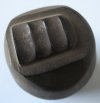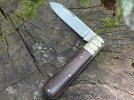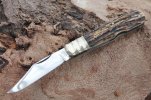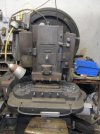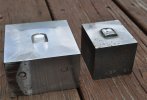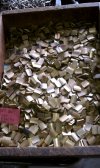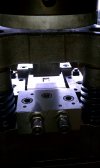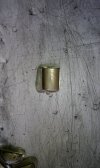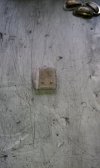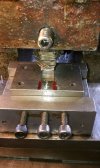waynorth
Dealer / Materials Provider
- Joined
- Nov 19, 2005
- Messages
- 33,347
Jack sent me this great-looking Lockwood!! Wonderful bolsters, and the blade stamp has my initials, and resembles my "guild stamp" from the Ancient Barlows! Cool as heck . . . . . .BUT, I kept tossing it into the un-categorized box! Why you might ask??
It was a thoughtful gift from a good friend. I will have to check his thumbs when I see him - see if he has steel implants!! So I kept ignoring the knife. I wouldn't let it into my consciousness!! Sigh . . . . .
Now, I have lucky thumbnails! I can open old Remington 1123s, and early GEC #23s, with pulls of 8,9 and even 10. And I love them!!
But this knife had pull I'd rate a 13 or more!!! None of my Macho club members nor I, could open it without seriously straining a steel blade lifter!!
So the time had come for a solution.
This Forum has provided many solutions to pocket knife problems. Someone actually did a pictorial on this problem! (Cambertree? Cambertree
)Was it you??
Cambertree
)Was it you??
Anyway, the problem is a poorly shaped/finished leading edge on the Tang. And (here's the best part!), it's accessible when the knife is open!!
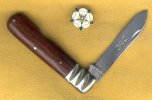
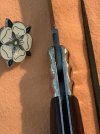
I rustled up a square needle file, and 15 - 20 minutes later, the knife has a delightful 8 opening pull!!
The closing force was already a nice 8 - 9.
I wish I could take better detail pics, but basically you gently file the leading edge, and clean out the knife well, and lubricate it!!
I love this knife!!
It was a thoughtful gift from a good friend. I will have to check his thumbs when I see him - see if he has steel implants!! So I kept ignoring the knife. I wouldn't let it into my consciousness!! Sigh . . . . .
Now, I have lucky thumbnails! I can open old Remington 1123s, and early GEC #23s, with pulls of 8,9 and even 10. And I love them!!
But this knife had pull I'd rate a 13 or more!!! None of my Macho club members nor I, could open it without seriously straining a steel blade lifter!!
So the time had come for a solution.
This Forum has provided many solutions to pocket knife problems. Someone actually did a pictorial on this problem! (Cambertree?
Anyway, the problem is a poorly shaped/finished leading edge on the Tang. And (here's the best part!), it's accessible when the knife is open!!


I rustled up a square needle file, and 15 - 20 minutes later, the knife has a delightful 8 opening pull!!
The closing force was already a nice 8 - 9.
I wish I could take better detail pics, but basically you gently file the leading edge, and clean out the knife well, and lubricate it!!
I love this knife!!


